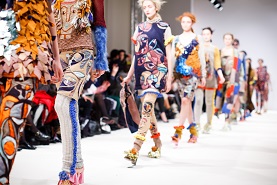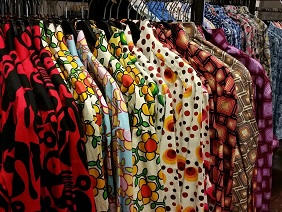It is an unfortunate fact that clothes, even those made of organic, low impact or recycled materials, are often not reused or recycled themselves. The majority end up in landfill or are incinerated. Inspired by the recently launched partnership of Metabolic with Fashion for Good, Metabolic looks at the dirty secret of the fashion industry, and offers some insight into what circular fashion could look like.
This article was first published on the site of Metabolic.
 Fashion cautiously moves towards sustainability
Fashion cautiously moves towards sustainability
The fashion sector is making strides towards sustainability, and a number of high-end designers, sports companies and fast fashion conglomerates are incorporating environmental and social initiatives in some form. Adidas has launched its ‘Parley’ shoe line, made from recycled plastic taken from the ocean, with each pair using around 11 plastic bottles. Stella McCartney sources organic cotton for their fashion line and H&M’s new offshoot brand Arket boasts traceability, by naming the factory and company that makes each product, even showing the factory location on a map. These efforts are heralded by some as necessary components of sustainable fashion, whilst they are accused by others for greenwashing to sell more stuff.
Fashion is the fifth most polluting industry in the world. The textile sector contributes to 20% of the world’s industrial water pollution and, despite the fact that only 2% of the world’s agricultural land is used for the production of cotton, this single crop is responsible for 24% of global insecticide use. Organic cotton goes some way to address these issues, but Stella McCartney produces a new line every 3-4 months. With each new season, what do they expect to happen to last year’s styles? Providing data on producers, like Arket does, is a move to increase transparency in the supply chain. But at the end of life, does H&M track where there products end up? The unfortunate thread that ties these ‘sustainable’ initiatives together is not their beginnings, but their end. Over 80 billion pieces of clothing are produced each year, and almost 80% end up in landfills. Using plastic waste to create shoes is a step towards circular fashion, but is it enough? These new shoes – fusions of plastic, fibres and rubber – may be impossible to recycle at the end of their lifetime.
 Fashion should be recyclable
Fashion should be recyclable
The fact of the matter is that clothing and accessories, in their current state, are not designed to be recycled. Upcycling, increasing or maintaining the value, is near impossible. Materials are often instead ‘downcycled’, meaning they are reduced in value or made unable to be recycled further. An important consideration is maintenance. The longer you can wear and make use of your clothing the better, and Patagonia has become a leader in clothing repair and maintenance. Their Worn Wear actively encourages customers to send their torn or damaged Patagonia back for a free repair before they buy something new. Though it may not be (currently) feasible to imagine a jacket or pair of boots lasting forever, the idea that clothing can and should be durable and repairable is antithesis to the fast fashion mantra dominating many retail clothing companies.
Envisioning a future where clothing doesn’t end up in landfills can take many forms, some more far-fetched than others. Fast fashion can be reimagined as slow fashion, with clothes lasting longer with supplier facilitated maintenance. Perhaps one day we will all spray on our clothing, which will last as long as needed and then dissolve away. Modular fashions (like modular buildings or technology) could be created: a ripped patch could be easily removed and sent for repair, and pieces altered for growth or changing seasons and styles. Articles can be built with recycling ‘designed in’; for example a shirt sewn in such a way that it could be unwound back to spool, and rethreaded into something new. If the creativity that is the heart of clothing design can be redirected into creating recyclable fashion of the future, then landfill-free styles may be walking down the runway sooner rather than later. This year, the Hong Kong Research Institute of Textiles and Apparel publicized a new method of using a hydrothermal chemical process to break down and blend textiles into polyester material that can be reused directly, though the process has yet to be scaled.
Towards a circular fashion industry
But we can’t wait just sit around and wait for potential future innovations. Working towards a circular fashion industry can start today. Research has shown that political and societal support are necessary to change the currently unsustainable textile industry. Political and corporate leaders can provide infrastructure to prolong the life of clothing via collaborative repair stations or take-back policies. Incentives can also be built in to promote textile collection and recycling with government subsidies or tax rebates. But there’s also a lot you can do as an individual – repairing or recycling clothing, which may mean seeking out options that may not be readily available. You can make an effort to buy second hand or durable clothes, found on sites like Buy Me Once. Additionally, you can vote with your wallet by buying from companies who provide opportunities for high quality recycling. For example Mud Jeans is a denim company that takes back jeans and uses the old jean as raw material for new denim after it has been cut, shredded, spun and rewoven.
The scale of the challenge and the urgent need for rapid change and circular fashion is why Metabolic has been working with partners in the industry to tackle systemic problems. We conducted a textile sector analysis for C&A Foundation – identifying how to achieve a closed loop. And we studied the sustainability and impact of linens, and how to reduce impacts to create circular uses, for Diversey.
Circular fashion needs support from all sides
Most recently Metabolic announced a partnership with Fashion for Good, innovation platform and convener for change in Amsterdam, with the joint goal to transition to a circular fashion industry. We’ll be supporting its start-up accelerator and scaling programs, as well as its public exhibitions. We’ll also be looking to develop tools and KPIs for circular design that it can use and promote. We realize that the path to sustainable fashion needs to come from all angles and support entrepreneurial endeavours, education and corporate and political campaigns. Together we hope to integrate circular economics into fashion initiatives. We believe we can reshape the fashion industry into a force for good. You can visit their space in Amsterdam, check out their website for more details.
Interesting? Then also read:
The comeback of flax and hemp
Design promotes the biobased economy
Fibres of the future: cotton and its limits
